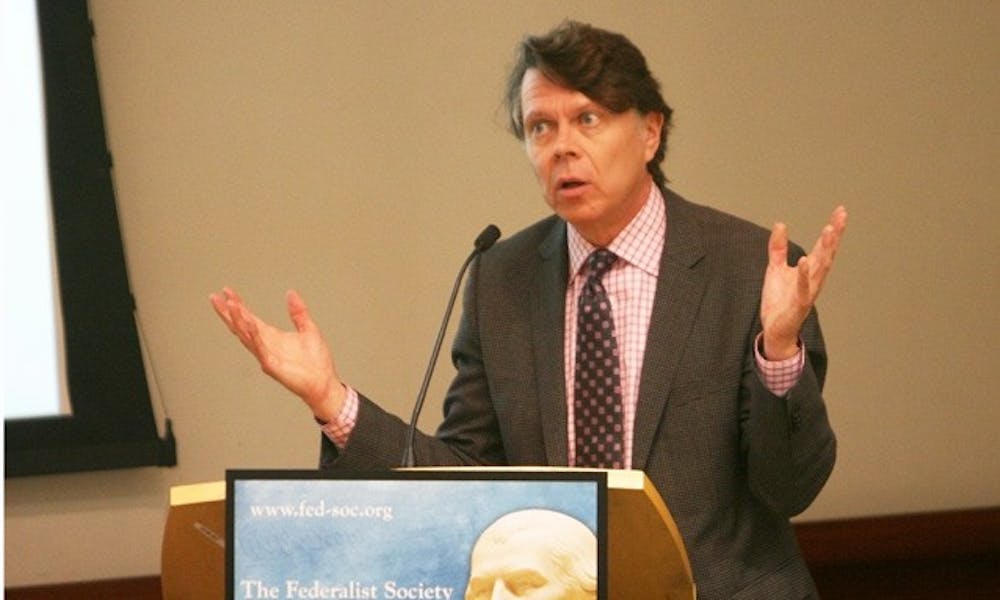The state of the middle class isn’t as hopeless as public opinion sometimes indicates, one expert said.
The Duke chapter of the Federalist Society, a conservative and libertarian organization present at many U.S. law schools, hosted Don Boudreaux, professor of economics at George Mason University, for a discussion about the quality of life among the American middle class Thursday. In his remarks, Boudreaux said he counters the media’s prevailing notion that economic situation of the American middle class is stagnant. He noted how many analysts argue that the quality of life for the middle class improved until the mid-1970s but then plateaued—a claim he believes is just a manipulation of data.
“You’re trying to be lawyers, you’re in a skeptic business,” Boudreaux said at the start of the presentation. “As a lawyer you can tell any story you want with your data but so can anyone else.”
Federalist Society President Phil Aubart, a second-year law student, said the group strives to give students the opportunity to hear alternative opinions.
“Many of the law schools all over the country are very liberal,” Aubart said. “The Society is interested in bringing a different point of view to these schools to show students both sides of arguments.”
Throughout his remarks, Boudreaux cited various statistics that reflect the strength and growth of the middle class. Real gross domestic product per capita, for example, grew by 80 percent between 1976 and 2006, he said. He supported his claims by comparing household income, hourly wages and the price of common goods.
The most commonly cited statistic supporting middle class stagnation is that the median household income has grown only 18 percent between 1976 and 2006, Boudreaux said. He noted, however, that when this statistic is adjusted for inflation and put in terms of other indexes, the growth is markedly higher. Using a personal consumption expenditure deflator, for example, demonstrates a 26 percent growth in median household income. And toward the other extreme, the Boskin condition—which tends to vastly overstate the rate of inflation—shows a 60 percent increase.
He also noted that when considering economic growth, analysts and the public should be sure to consider median values.
“It’s better to look at medians [because] they are not as sensitive to large outliers,” Boudreaux said. “If Bill Gates walks in here, the average wealth of the people in the room would rise dramatically, but the median would stay the same.”
Household income should also be considered in term of household size, Boudreaux said. If a household is smaller but has a greater income, that should be noted.
The average household size has decreased from 2.86 people in 1976 to 2.56 people in 2006—a 10 percent decrease, Boudreaux added.
“You can’t compare households just by size,” Boudreaux said. “It is typical to also divide households by type. Back in 1976, two-thirds of all households were married couples, [but] by 2006 that was down to less than 50 percent. “
And regarding household income, Boudreaux said, there has actually been a 32 percent increase in household median income—once adjusted for the 10 percent decrease in household size—in the past 30 years, evidence that negates the stagnant middle class argument.
When broken down by married and single categories, the median household saw other increases, with the single female household, for example, seeing the highest increase of 55 percent in income in the last 30 years.
Worker pay—including benefits—in the 1976-2006 period saw similar increases, Boudreaux said, rising as high as 28 percent, according to the consumer price index.
Boudreaux also compared the prices of common items and how many hours a worker had to work for the item in 1976 versus in 2006. A worker in 1976 needed to work 155 hours to buy a typewriter, tires and a microwave. Yet a worker in 2006 could buy the modern equivalents after working just 60 hours, he said, noting that this is evidence of both economic and technological advancement.
Alex Herskowitz, Law ’11 and an associate in research in the Office of the Dean of the Law School, asked Boudreaux about the relative versus the absolute increase in happiness, particularly related to the growth of the wealth of the upper class.
Boudreaux said that about two-thirds of the increase in income of the wealthiest 20 percent of the population is a result of various statistical anomalies.
“The chief reason is globalization,” he added. “If you have people who are highly productive, they can reach more customers with an expanding global economy.”
Herskowitz attended this event last year as well, after taking a class related to the subject matter.
“There was one particular seminar on the relationship between happiness and decision making,” he said. “I am very interested in the political implications of happiness and inequality.”
After the event, Jonny Havens, a second-year law student noted that Boudreaux presented an argument that is rarely heard.
“It was very interesting to see a different perspective on the current wealth issue, the one percent side of the 99 percent argument,” Havens said.
Get The Chronicle straight to your inbox
Signup for our weekly newsletter. Cancel at any time.

